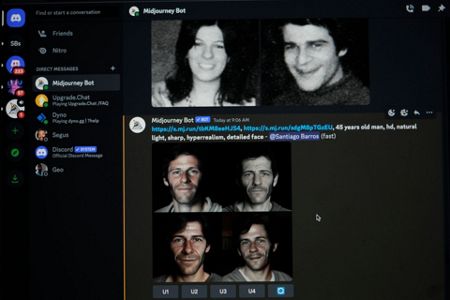BUENOS AIRES, Argentina (AP) — If a baby was taken from their parents four decades ago during Argentina's military dictatorship, what would that person look like today?
Argentine publicist Santiago Barros has been trying to answer that question using artificial intelligence to create images of what the children of parents who disappeared during the dictatorship might look like as adults.
Almost every day, Barros uploads these images to an Instagram account called iabuelas, which is a portmanteau in Spanish for artificial intelligence, or IA, and grandmother, or abuela — taken from the well-known activist group Grandmothers of Plaza de Mayo that searches for missing children.
“We have seen the photos of most of the disappeared, but we don’t have photos of their children, of those children who were stolen," Barros told The Associated Press. "It struck me that these people did not have a face.”
During Argentina's bloody dictatorship from 1976 to 1983, military officials carried out the systematic theft of babies from political dissidents who were detained or often executed and disposed of without a trace. The babies were often raised by families linked to the dictatorship, or those ideologically aligned with it, as if they were their own.
Using an app called Midjourney, Barros combines photos of the disappeared fathers and mothers from the public archive of the Grandmothers website, creating images of what the faces of their children might look like as adults today. For each combination, the app shows two female and two male possibilities. Barros then chooses the image of each gender that seems most realistic.
The project does not intend to replace efforts headed by the Grandmothers group of identifying grandchildren through DNA testing. Instead, Barros says, the goal is to stir the conscience of those over 46 who may have doubts about their origin and to serve as a reminder of the more than four decades the grandmothers have spent trying to locate these children.
The Grandmothers of the Plaza de Mayo estimates around 500 children were snatched from their parents during the dictatorship. The group has located 133 grandchildren through genetic analysis.
The group appreciates Barros' initiative as a way to raise awareness about the children who were stolen or kidnapped during the dictatorship. But they warn that the only infallible tool to link these people with their families of origin is DNA testing that continues to be carried out by the National Genetic Data Bank, whose creation they promoted in 1987.
In addition to working with photos from the Grandmothers' archives, Barros uses photographic material provided by interested parties.
In some cases, those who have accessed iabuelas have noticed in the images a tendency towards standardization, raising questions about their approximation to reality. But in others, families searching for a lost relative have been shocked by the resemblance they found in those faces to blood relatives.
Such was the case for Matías Ayastuy, who contacted Barros and provided him with photos of his disappeared parents to see what a possible brother or sister would look like. His mother, Marta Bugnone, was kidnapped in 1977 when she was pregnant. By combining the image of her and that of his father, Jorge Ayastuy, the AI tool was able to come up with some impressive results.
“A lot of people see the masculine image as similar to me. But what generated something very, very strong for me was the feminine one. I found a very striking resemblance to a cousin of mine," Ayastuy said.
In the month since Barros' initiative launched, there have not yet been any known cases of an adult seeing themselves as similar to one of his images and then starting a formal process of identification.
All the images of the disappeared parents and their possible children are uploaded to the Instagram account with a note specifying that iabuelas is an “unofficial artistic project” and that results generated by artificial intelligence can be inaccurate.
Pedro Sandoval, a grandson who was identified in 2006, embraced Barros’ initiative at first, but later decided it was imperfect because it seems to rely too much on “standardized patterns” of people with European features. His mother, Liliana Fontana, and his father, Pedro Sandoval, are among the 30,000 missing persons counted by humanitarian organizations.
Barros acknowledged the app might be skewed, but noted that many of the disappeared people had European ancestors, in a country with strong European immigration.
As for the grandmothers, they don't want the AI campaign to create false expectations for those who find similarities with the generated images, so they have urged it to be taken with a grain of salt.
“It is a campaign that shows simulations about possible faces of sons and daughters of the disappeared, but we know that people are much more than 50 percent of each of their parents and that foreign applications are set with genotypes of their populations," the group said in a statement at the end of July. “Therefore, the results are not accurate.”
___
Associated Press video journalist Victor Caivano contributed to this report.
Copyright 2023 The Associated Press. All rights reserved. This material may not be published, broadcast, rewritten or redistributed without permission.










